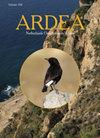The Diet of the West African Crested Tern Unveiled by an Analysis of Otoliths Collected Over 20 Years along Its Main Breeding Sites
IF 0.8
4区 生物学
Q3 ORNITHOLOGY
引用次数: 0
Abstract
This study reports on the diet of breeding West African Crested Terns Thalasseus albididorsalis on the basis of otoliths found in excrement (a mixture of pellets and faeces near nests). During the period 1998–2019, towards the end of the incubation period, excrement samples were collected from breeding colonies on islands, along the Atlantic coast from Mauritania to Guinea. In 31 samples with a total of 8956 otoliths we identified 53 fish families, 75 genera and 101 species. Twelve fish families occurred in more than 2% of the samples. The families of Haemulidae, Mugilidae, Pristigasteridae and Sparidae were particularly numerous (found in 10.5–15.7% of samples). The most numerous species were Bigeye Grunt Brachydeuterus auritus (9.8%) and West African Ilisha Ilisha africana (13.3%). There were marked differences in the diets of terns from the Banc d'Arguin (Mauritania), The Langue de Barbarie (northern Senegal) and all more southerly sites together (Senegal, The Gambia, Guinea Bissau and Guinea). On Ile aux Oiseaux, Delta du Saloum, Senegal, we found long-term changes in the diet of the terns with a marked decrease in Brachydeuterus auritus and the family Sparidae and a strong increase in Ilisha africana. Our analyses suggest that breeding West African Crested Terns are food generalists rather than specialists. This is surprising in view of the general trend in terns of the genus Thalasseus. There are indications that chick diets may differ from those of adults.通过对其主要繁殖地20多年来采集的耳石的分析揭示了西非冠毛燕鸥的饮食
这项研究基于粪便中发现的耳石(巢穴附近的颗粒和粪便的混合物),报道了繁殖西非白背燕的饮食。1998年至2019年期间,在孵化期即将结束时,从毛里塔尼亚到几内亚的大西洋沿岸岛屿上的繁殖地采集了排泄物样本。在总共8956个耳石的31个样本中,我们鉴定了53个鱼类科、75个属和101种。超过2%的样本中出现了12个鱼类家族。血蛛科、麻瓜科、原蛛科和雀科的数量特别多(在10.5-15.7%的样本中发现)。数量最多的物种是Bigeye Grunt Brachydeuterus auritus(9.8%)和西非Ilisha Ilisha africana(13.3%)。来自Banc d’Arguin(毛里塔尼亚)、Langue de Barbarie(塞内加尔北部)和所有更南部地区(塞内加尔、冈比亚、几内亚比绍和几内亚)的燕鸥在饮食上存在显著差异。在塞内加尔萨洛姆三角洲的Ile aux Oiseaux,我们发现燕鸥的饮食发生了长期变化,其中Brachydeuterus auritus和Sparidae家族的燕鸥数量显著减少,而Ilisha africana的燕鸥则大幅增加。我们的分析表明,繁殖西非冠毛燕鸥是食物通才,而不是专家。鉴于地中海燕鸥属燕鸥的普遍趋势,这是令人惊讶的。有迹象表明,小鸡的饮食可能与成年人不同。
本文章由计算机程序翻译,如有差异,请以英文原文为准。
求助全文
约1分钟内获得全文
求助全文
来源期刊

Ardea
生物-鸟类学
CiteScore
2.10
自引率
0.00%
发文量
49
审稿时长
>12 weeks
期刊介绍:
Ardea is the scientific journal of the Netherlands Ornithologists'' Union, and is published since 1912. The journal welcomes manuscripts reporting significant new findings in ornithology, in particular those covering the ecology, life history, and evolution of birds, and including sound descriptive work. Ardea publishes Original research papers, Short notes and Book reviews. In addition to the regular three issues per year, Ardea publishes specials that contain conference or workshop proceedings (produced on request).
 求助内容:
求助内容: 应助结果提醒方式:
应助结果提醒方式:


